The New York City Ballet premieres Justin Peck’s new ballet and offers works by Thatcher, Binet, Schumacher, and Wheeldon.
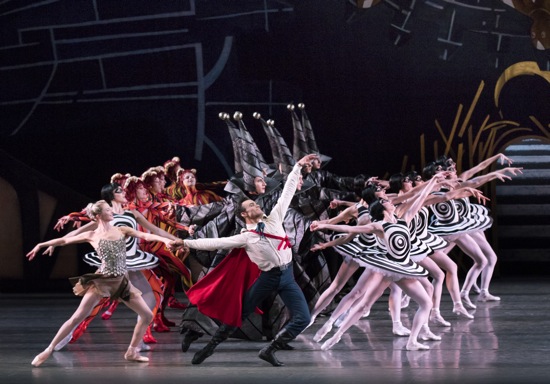
Justin Peck’s The Most Incredible Thing. Sterling Hyltin and Taylor Stanley dance in front of the figures that mark the hours of the magical clock he has created. Photo: Paul Kolnik
George Balanchine was reared on story ballets and gradually weaned himself into abstraction, but he never forgot how to tell a good yarn. The New York City Ballet’s vastly gifted young resident choreographer, Justin Peck, was reared on Balanchine and suddenly—without much experience with narrative—given the chance to choreograph a fairytale extravaganza in one long act based on a Hans Christian Andersen story.
Andersen’s “The Most Incredible Thing” would seem to lend itself to being transformed into a ballet, something like the last act of The Sleeping Beauty or the last act of The Nutcracker, but by the time all the variations are performed in those ballets, the moral heart of the story has been made clear. Andersen, on the other hand, cuts straight (well, almost straight) to the opulence. Here’s his plot. The king of a nameless country offers the hand of his daughter to whoever can create the most incredible thing. A poor young man has constructed a fantastic clock, in which different lifelike figures emerge to strike each hour. He wins the competition and is about to be awarded the princess when another contestant smashes the clock. Ooh, says everyone, now that is the most incredible thing! Destructive evil and a too credulous populace are about to win the election (sorry, the girl), when the figures in the clock come magically to life and defeat the man (called The Destroyer in Peck’s ballet) before disappearing. The Princess and the clockmaker marry. It has been speculated that Andersen wrote his 1870 story in response to the savagery of the Franco-Prussian War.
Peck’s ballet, The Most Incredible Thing, is a collaboration among the choreographer; composer Bruce Dessner; Marcel Dzama, who designed the visuals and costumes; and Brandon Stirling Baker, who created the lighting. There are over fifty dancers in the cast, including eleven talented little girls from the School of American Ballet. The dazzling collage of exotic painted images that serves as a front-cloth opens to reveal an even more dazzling backdrop, which represents the gears and levers of the clock. Problem one: How does the bad guy “smash” a stage-sized painting hanging on the wall? (It probably can’t suddenly fall, although if it were seen in projections (as it was in the version of The Most Incredible Thing that Javier De Frutos and the Pet Shop Boys created for the Sadlers Wells Ballet in 2011), it could dissolve into disintegrating images. . . .). Amar Ramasar, who plays The Destroyer, with his right arm turned into a silver club, can thrash evilly around all he likes (and he does that with marvelous conviction), but its mostly air that he’s damaging. His duet with the Princess (Sterling Hyltin) is appropriately frightening and borderline obscene, what with that thrusting club.
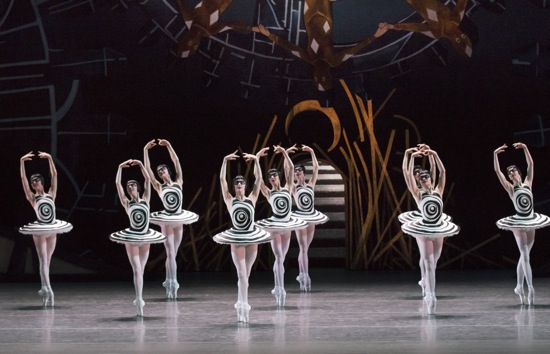
New York City Ballet dancers as the Nine Muses in Justin Peck’s The Most Incredible Thing. Photo: Paul Kolnik
So the ballet is visually entrancing, although not always clear in how it expresses the plot. For instance, the King is represented by two tall dancers (Russell Jantzen and Ask La Cour). They walk in lock-step, as in a three-legged race, their heads completely hidden in helmets with only a slit for the eyes. The moment when they break apart like an armored egg to reveal the Princess behind them is exciting, but what does it say about this kingdom? More important, how can such a restricted monarch run a major competition? Answer: He doesn’t even try.
Peck has created a ballet that falls somewhere between a convincing story and a suite of dances with extra dramatic moments. There are, unfortunately, no courtiers, spectators, judges, or other contestants. We see only the Creator (Taylor Stanley: very fine) dancing excitedly and expertly around the stage. He hasn’t yet demonstrated the clock with its figures that strike the hours, although he has fallen for the Princess (Sterling Hyltin), with whom he has a sweet duet.
In Andersen’s tale, the figure who strikes one o’clock is Moses, just beginning to write his first Commandment. Not a great role for a dancer, and I can understand why Peck and NYCB might want to avoid Andersen’s Christian beginning and ending (announcing the birth of Jesus). But why a Cuckoo (the marvelous Tiler Peck) to symbolize one o’clock and reappear at ten (instead of the Commandments)? I get it, but this is no cuckoo clock that Dzarma has designed. The bird was borrowed from Andersen’s four o’clock figures, who represent the seasons, and replaced in that quartet by Gwyneth Muller as a Spring Bird, looking more like a whirling red rose than anything avian.
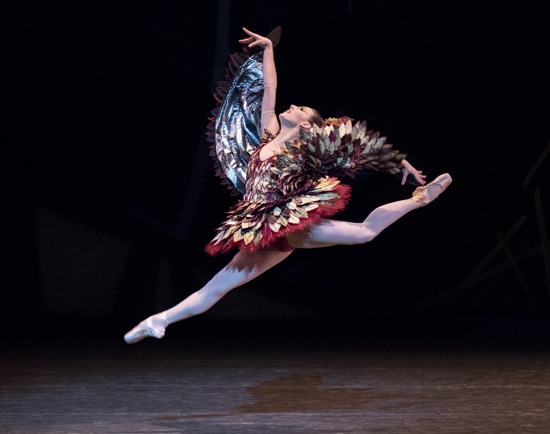
Tiler Peck as the Cuckoo Bird in The Most Incredible Thing . Photo: Paul Kolnik
Peck is an excellent choreographer. He has no problem making clever, eye-catching, expressive steps for, say, Adam and Eve (Rebecca Krohn and Adrian Danchig-Waring: two o’clock) or buoyant ones for Daniel Ulbricht, suited up like a dice showing six. It’s touching that two of the little eleven o’clock girls try to stop The Destroyer by clinging to his legs. Classicist that he is, Peck chooses not to mine the differences between, say, the Nine Muses; they’re women in identical eye-catching white tutus with black pinwheels on them. The Five Senses, the Seven Deadly Sins, and the Eight Monks are other handsome ensembles with remarkable costumes (as I recall it’s the Senses who have hooped dresses that can lift and turn them briefly into headless figures that might have graced an Oskar Schlemmer work of the 1920s or the sculptural aspect of Alwin Nikolais’ costumes).
Actually, The Most Incredible Thing teeters among three identities: a dramatic ballet, a formal display of steps, and a costume parade. Given how expensive the production must have been and NYCB’s packed rehearsal schedule, it’s unlikely that Peck could do more than tweak his ballet a little here and there, should he even wish to. That’s a pity. His considerable talent and intellect might well urge him to take a second look with the eye of a dramaturge and wonder what we spectators are making of the tale. (I should add, however, that the applause was enthusiastic and that many spectators rose to their feet.)
The program for this Gala evening included Christopher Wheeldon’s 2010 Estancia and three ballets that premiered this past September: Miles Thatcher’s Polaris, Robert Binet’s The Blue of Distance, and Troy Schumacher’s Common Ground. It was interesting to consider how many of the ballets shown (including Peck’s work) suggested a searching hero or heroine gazing toward a distant horizon or a new prospect.
In Wheeldon’s ballet, which I missed seeing in 2010, the hero is a city boy getting in touch with the land. The music was written by Alberto Ginastera in 1941 for American Ballet Caravan, a company cobbled together for a South American tour from Lincoln Kirstein’s Ballet Caravan and the American Ballet that Kirstein had formed with George Balanchine. That company dissolved before Balanchine could get around to fitting choreography to the score. The 2010 New York City Ballet production premiered as part of a season featuring the designs of Santiago Calatrava—in the case of Estancia, a gorgeous moody landscape with desert space backed by shadowy tropical foliage that brings to mind the composer’s native Argentina and the poem by José Hernandez that inspired the ballet.
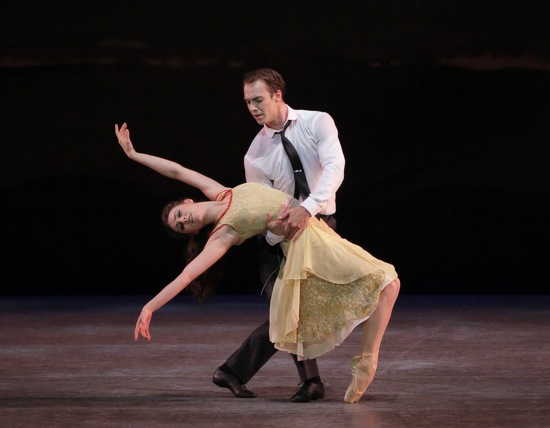
Tiler Peck yields to Tyler Angle in Christopher Wheeldon’s Estancia.
Photo: Paul Kolnik
It’s hard not to think of Agnes de Mille’s 1942 Rodeo, while watching Estancia. And, although Ginastera’s music is unlike Aaron Copland’s music for Rodeo, it often has the equivalent of its intense galloping beat. (It also has spoken and sung passages from Hernandez’s “El Gaucho Martin Fierro” —delivered by the excellent baritone Steven Labrie in costume.) Like the cowhands in the earlier ballet, Peck’s vigorous gauchos wear the appropriate hats, hunker down, and dance spiritedly. But the only corral is the four poles they occasionally hold to indicate a fence. The heroine isn’t a tomboy who, in the end, gets in touch with her laggardly femininity; she’s a ranch woman in a dress who knows how to swing a lasso. When the visiting City Boy (Tyler Angle) throws off his jacket and shows his eagerness to work alongside her and her not very welcoming men, she (Tiler Peck) sets him a test.
In this ballet, the horses are not imagined. Hooded brown unitards with manes and tails identify Megan Johnson, Emily Kikta, Isabelle LaFreniere, and Unity Phelan as wild horses, with Andrew Veyette as their stallion. When Country Girl hands City Boy the reins to the captured stallion, he’s predictably yanked off his feet, and she has to go chase the horse. His city friends come to take him away, but he gestures, “I’m staying here.” And, yes, he shows his mettle, does better with the horses next time around, and wins the girl. Peck and Angle perform their roles marvelously; he, who goes through more changes than she, is a particularly fine and subtle actor.
Wheeldon makes dance passages that show the men of the estancia as tough and hardworking; their women have movements that allude to planting or reaping. He also times the developing drama impeccably, and finds small details that reveal character. For instance, City Boy is lounging on the ground, staring at the sky. Country Girl, entering in a hurry, trips over his feet. No big deal, but he’s for sure in the way. Once bonded, they lie down together in that same spot, and a light change later, the gauchos roughly, good-naturedly, and without comment wake them up when it’s time to get to work. No prudery here. And no gender biases. The dancers-as-horses idea strikes me as a bit whimsical, but the unpredictability and possible danger they provide gives the story its teeth and its turning point. This lively and engaging ballet is not just about falling in love.
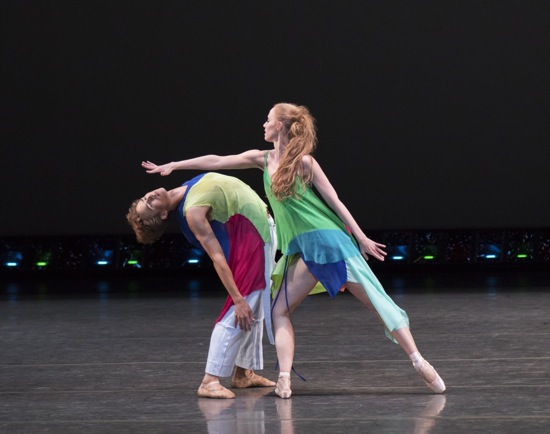
Joseph Gordon and Teresa Reichlen in Troy Schumacher’s Common Ground. Photo: Paul Kolnik
One of the pleasures of attending NYCB performances is seeing dancers take over new roles. Common Ground was performed at the Gala by it original cast, wearing the unruly costumes by Marta Marques and Paolo Almeida (what with the vivid colors and trailing strings, you can imagine that kites have fallen from the sky and draped themselves over whatever dancer happened to be below). In Polaris, however, corps de ballet member Emily Gerrity has moved into the role created for Tiler Peck, and Ashly Isaacs has taken over Gerrity’s less prominent part. In The Blue of Distance, three other corps dancers—Sara Adams, Unity Phelan, and Indiana Woodward—perform roles originally designed for principal dancers Sterling Hyltin, Rebecca Krohn, and Sara Mearns. They’re like racehorses who’ve been waiting in the paddock, and, hey, someone just opened the gate a crack.
Ghaleb Kayali, Emilie Gerrity, Craig Hall, Ashly Isaacs, Andrew Scordato (hidden), Daniel Applebaum, and Taylor Stanley.
